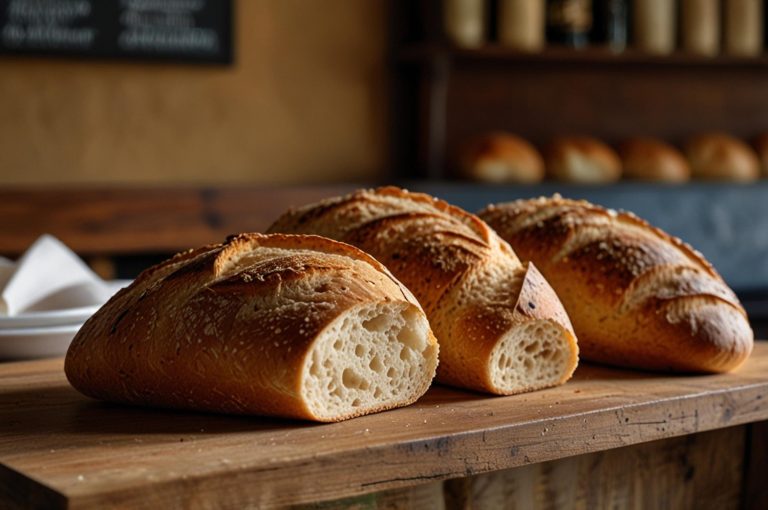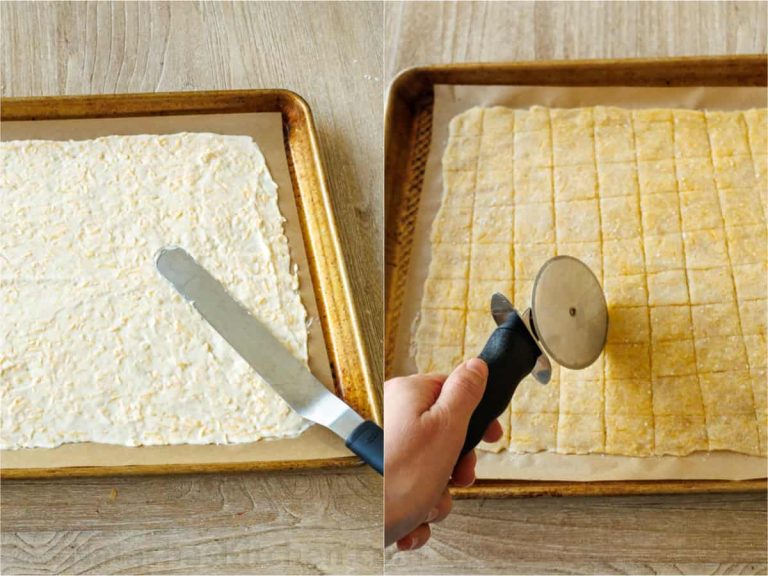Store Sourdough Bread Properly: Tips for Long-Lasting Freshness
The average household throws away nearly 40% of their homemade bread. All those hours spent carefully feeding, kneading, and baking end up in the trash.
Most of us know the feeling. You dedicate days to nurturing your sourdough starter and crafting the perfect loaf. Then you watch helplessly as it becomes rock-hard or develops mold within days. Here’s the good news —toring sourdough bread correctly can extend its life from a few days to over a week.
Proper storage plays a significant role in maintaining that crusty exterior and soft, chewy interior we all love. This applies to both experienced bakers and those who have just started their first sourdough experience. We’ll show you how to keep your sourdough fresh longer by explaining the science behind bread staling and teaching you climate-specific storage techniques.
Want to save every loaf you bake? Let’s examine the perfect sourdough storage tips and tricks.
Understanding Sourdough Storage Science
Let’s tuck into the fascinating science behind bread preservation to learn the best ways to store sourdough bread. Sourdough behaves quite differently from regular bread, and this knowledge can help us keep it fresh longer.
Chemical Process of Bread Staling
A loaf’s staling process starts right as it comes out of the oven. Most people think staling happens just because bread loses moisture. The biggest problem comes from retrogradation, where starch molecules rearrange into a more rigid structure. Starch granules become gel-like during baking as they absorb water. The bread becomes firmer and less pleasant as these starches return to their crystalline form while cooling.
Role of Hydration Levels
Hydration is a vital part of bread preservation. Different hydration levels affect your sourdough in specific ways:
| Hydration Level | Characteristics | Storage Impact |
|---|---|---|
| 65-70% | Firmer crumb | Slower staling |
| 75-80% | Open texture | Better moisture retention |
| 80%+ | Very open crumb | Requires careful storage |
Loaves with higher hydration stay fresh longer naturally. These loaves can develop mold more quickly in humid conditions.
Impact of Ingredients on Shelf Life
Sourdough’s impressive shelf life comes from its unique ingredients and fermentation process. These elements help preserve our bread:
- Lactic acid bacteria create natural preservatives
- Lower pH levels prevent harmful microorganism growth
- Organic acids slow down starch retrogradation
- Naturally produced compounds inhibit mold formation
Beneficial compounds,mainlyy lactic and acetic acids from fermentation, create an environment that extends bread’s freshness. Properly fermented sourdough lasts 5-7 days with correct storage, while regular bread stays fresh for 2-3 days.
These scientific principles guide our storage decisions and timing. Working alongside these natural processes helps maintain the quality of our sourdough for longer.
Choosing the Right Storage Method
Picking the right storage method for your sourdough bread requires more than a simple solution. Your bread’s freshness depends on several important factors that need careful thought. Here’s how to choose the perfect storage solution for you.
Evaluating Your Climate and Environment
Your local climate significantly affects how you should store sourdough bread. These factors make a big difference:
- Humid environments need storage solutions that prevent excess moisture buildup
- Dry climates require a focus on keeping the bread’s internal moisture
- Temperature fluctuations need adaptable storage methods
Matching Methods to Bread Types
Each type of sourdough needs its storage approach:
Crusty Artisan Loaves:
- First 24 hours: Leave uncovered or under a bread dome
- After 24 hours: Store in a breathable bag or bread box
Soft-Crust Breads:
- Store immediately in an airtight container or plastic bag
- Keep at room temperature for up to 5 days
Storage Container Comparison Guide
This comparison helps you pick the best storage method:
| Storage Method | Best For | Climate Suitability | Shelf Life |
|---|---|---|---|
| Bread Box | Crusty loaves | Moderate humidity | 3-4 days |
| Linen Bag | Artisan bread | Humid climates | 2-3 days |
| Dutch Oven | Overnight storage | Any climate | 1-2 days |
| Paper Bag | Short-term storage | Dry climates | 1-2 days |
| Plastic Bag | Soft-crust bread | Low humidity | 4-5 days |
Success comes from matching your storage method to your bread type and environment. Bread boxes excel in moderate climates and offer the perfect airflow and moisture retention balance. Linen bags work best in humid areas because they let excess moisture escape while protecting the bread.
Your storage routine should start when the bread comes out of the oven. Let your loaves cool completely before storing them. Heat trapped inside creates condensation that leads to early spoilage.
Essential Storage Techniques
Your sourdough bread can stay fresh for over a week if you know the proper storage techniques. Let’s look at the significant methods we’ve refined through years of baking.
Proper Cooling and Cutting Methods
Patience plays a vital role when cooling sourdough bread. You should wait at least 1-2 hours after taking your loaf from the oven before cutting it. This step helps the internal structure tobe set correctly. Cutting too early creates a gummy texture that you can’t fix.
The perfect slice starts by cutting your loaf in half and placing it cut-side down on the cutting board. This method creates a natural moisture seal that protects the bread’s interior while keeping that crusty exterior intact.
Temperature and Humidity Control
Temperature and humidity go together when storing sourdough. Here’s what we’ve learned:
| Condition | Ideal Range | Storage Adjustment |
|---|---|---|
| Temperature | 68-72°F | Use bread box or counter |
| Humidity | 40-50% | Adjust container ventilation |
| High Humidity | Above 60% | Reduce water when baking |
The original recipe contains less water for humid environments. Try reducing it by 25g until you find the right balance.
Airflow Management Tips
The perfect crust-to-crumb ratio depends on good airflow management. These strategies work well:
- Position bread away from direct air currents
- Use a bread box with adjustable vents
- Store cut-side down on wooden surfaces
- Avoid plastic bags, which trap moisture
The first 24 hours after baking need careful airflow management. Some air circulation without too much exposure helps maintain that striking contrast between crust and crumb, which makes sourdough unique.
Note that your local climate affects how these storage methods work. Watch how your bread responds to these storage techniques and adjust them for the best results.
Climate-Specific Storage Solutions
Storing sourdough bread can be challenging in different climates. Our extensive baking experience in regions of all sizes has helped us develop strategies for every environment.
Humid Climate Storage Strategies
Moisture control is vital in humid environments. The hydration in recipes needs a 5-10% reduction when humidity levels go above 60%. These methods have proven most effective:
- Use cold water or ice in the dough to slow fermentation
- Increase salt percentage slightly (up to 2.2%) to control fermentation
- Store bread in breathable linen bags to prevent moisture buildup
- Monitor bannetons regularly to prevent mold formation
Dry Climate Adaptations
Our experience in arid regions like New Mexico shows that preventing moisture loss is a vital part of the process. These methods work best in environments with 20-30% humidity:
| Strategy | Purpose | Duration |
|---|---|---|
| Sealed containers | Moisture retention | 3-4 days |
| Higher hydration | Compensate for dryness | During baking |
| Autolyze period | Better water absorption | 15-20 minutes |
Seasonal Storage Adjustments
Bread quality depends on adapting storage methods to changing seasons. The focus shifts from preventing rapid fermentation and mold growth in summer to moisture retention and temperature stability in winter.
The best year-round storage requires seasonal adjustments:
Summer Adjustments:
- Reduce starter percentage to slow fermentation
- Store in more excellent locations (65-70°F)
- Monitor humidity levels daily
Winter Adjustments:
- Increase hydration slightly
- Use sealed containers more frequently
- Maintain consistent room temperature
Experience has taught us that successful sourdough storage requires more than just the correct container. Understanding and adapting to your environment’s unique challenges makes all the difference.
Troubleshooting Storage Problems
Even with the best practices for sourdough bread, storage problems can pop up. We’ve faced many storage issues during our baking trip and want to share solutions that work.
Preventing Mold Growth
Mold becomes our worst enemy when we store sourdough bread. Mold runs in warm, humid environments, especially when bread sits in plastic bags. These practices help prevent mold:
- Keep bread away from heat sources (stove, dishwasher, refrigerator top)
- Store in cool, dry spots between 68-72°F
- Use breathable containers for proper airflow
- Check humidity levels where you store
- Clean storage containers with vinegar solution regularly
Addressing Texture Issues
We spot the cause first before fixing texture problems. Here’s our guide:
| Texture Issue | Likely Cause | Our Solution |
|---|---|---|
| Soggy Crust | Trapped moisture | Switch to breathable storage |
| Tough Crust | Over-drying | Use Dutch oven storage method |
| Gummy Interior | Cut too soon | Allow complete cooling before cutting |
| Crumbly Texture | Too much moisture loss | Adjust hydration levels |
Most texture problems result from incorrect cooling or cutting methods. Our bread needs 2-3 hours of complete cooling before storage, which works great for standard loaves.
Reviving Stale Bread
Your stale loaf still has hope! We’ve mastered anuniqueg revival trick that brings day-old sourdough back to life. Here’s our tested method:
- Preheat oven to 300°F
- Run water over the bread’s exterior (avoid cut surfaces)
- Place directly on oven rack
- Bake for 5-15 minutes until soft
- Cool slightly before serving
This trick works best with crusty sourdough that’s 1-2 days old. We’ve used this method hundreds of times, and the bread always comes back with a crispy crust and soft interior.
Bread older than two days works better as croutons or breadcrumbs instead of trying to revive it. Our years of experience show that good storage dramatically reduces the need for revival tricks.
Conclusion
The correct storage method can turn sourdough bread from a quick treat into a lasting delight. Our deep dive into bread science, storage methods, and critical techniques shows how to keep that perfect crust and tender crumb intact.
Your success with sourdough storage adapts to your local weather and seasons. Our climate-specific solutions and fixes will help keep your bread fresh for much longer and reduce waste.
Want to take your sourdough experience to new heights? You can raise your bread and pizza skills with an authentic artisanal sourdough starter from The Yeast We Can Do. Our small-batch starter creates exceptional bread and pizza with that perfect tangy flavor and signature crust. This works excellent for passionate home bakers and restaurant owners who want to add true sourdough’s unique flavor to their menu. Your baking can change today – just email john@theyeastwecando.com to get our premium sourdough starter.
Note that good sourdough needs proper care. These storage tips will help you enjoy fresh, tasty bread for days. Ideally, you store ready sourdough – crusty, flavorful, and waiting for you.
FAQs
How can I extend the shelf life of my sourdough bread? To make your sourdough bread last longer, store it in a bread box or on the counter at room temperature (68-72°F) for the first 24 hours. After that, you can keep it in a breathable bag or bread box. For more extended storage, wrap it tightly in plastic or foil and store it in the refrigerator. Allow the bread to cool completely before storing it to prevent moisture buildup.
Why does my sourdough bread spoil quickly? Sourdough bread can be spoirapidly due to several factors. Unlike commercial bread, it doesn’t contain preservatives. Additionally, warm and humid conditions can accelerate mold growth. Proper storage techniques, such as keeping the bread in a cool, dry place and using breathable containers, can help extend its freshness for a few days.
What’s the best way to wrap sourdough bread? The best way to wrap sourdough bread is to use a breathable material that allows some air circulation while still protecting the bread. Options include wrapping it in a clean tea towel, storing it in a paper bag, or using a beeswax wrap. These methods help maintain the bread’s crust while preventing excessive moisture buildup.
How long can I expect my sourdough bread to stay fresh? When appropriately stored at room temperature, sourdough bread can stay fresh for 3-7 days. The duration depends on storage conditions, climate, and the bread’s hydration level. Crusty artisan loaves tend to maintain their quality longer than soft-crust varieties. Consume the bread within the first few days after baking for maximum freshness.
Should I store my sourdough bread in a plastic bag? Storing sourdough bread in a plastic bag can lead to mixed results. A wholly sealed plastic bag can make the crust soft due to trapped moisture, while a partially sealed bag might dry the bread. If you choose to use a plastic bag, it’s best for short-term storage of soft-crust breads. Users can use ore breathable storage solutions like paper bags or bread boxes for crusty sourdough.
How can I revive stale sourdough bread? To revive stale sourdough bread, try this method: Preheat your oven to 300°F, lightly moisten the bread’s exterior with water (avoiding cut surfaces), place it directly on the oven rack, and bake for 5-15 minutes until it softens. This technique works best for breas no more than 1-2 days old and can restore the crust’s crispiness and the interior’s tenderness.
How does climate affect sourdough bread storage? Climate significantly impacts sourdough bread storage. In humid environments, focus on preventing moisture buildup by being breathable storage containers and reducing the bread’s hydration during baking. In dry climates, the challenge is retaining moisture, so consider using sealed containers and increasing the water content.—Changingyourstorage method based on your local climate and seasonal changes.
Can I store sourdough bread in the refrigerator? You can store sourdough bread in a thfridgeor. Still, it must be adequately covered to prevent dgusee a ziplock bag or a large plastic food container with a tight-fitting misremembered that refrigeration can alter the bread’s texture, so it’s best to consume refrigerated bread within a few days and toast it before eating for the best flavor and texture.






